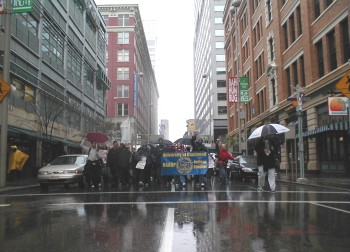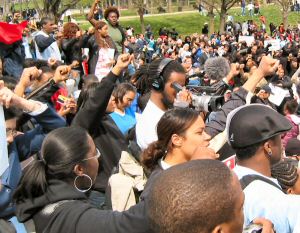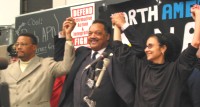| |
|
 |

From its founding in 1997, UEAALDF saw that
the U of M affirmative action cases represented a potential springboard
for a new civil rights movement that could put a halt to the decades-long
erosion that has taken place in the gains of the last civil rights
movement.
UEAALDF also realized that to achieve victory, the new civil rights
movement would have to be shaped by the boldness and idealism of youth.
In the
Courtroom
Our legal work is always fully integrated with education and organizing. Court hearings provide an opportunity to educate the nation and to set the terms of public debate on civil rights issues.
For instance, UEAALDF presented the most aggressive, comprehensive and in-depth case for affirmative action ever presented in the U.S. We moved the discussion on affirmative action from one about “racial preferences” to one about equality and opportunity – from the arguments in Bakke to those of Brown. Many of America’s pre-eminent experts in their fields testified pro bono for the Grutter intervenors, including Harvard Professor Gary Orfield, Columbia Professor Eric Foner, Duke Professor John Hope Franklin, Howard Professor Frank Wu, UC Berkeley Professor Eugene Garcia and UCLA Professor Walter Allen.
In the
Classroom
To educate students, UEAALDF has sponsored annual educational symposia at the University of Michigan, the University of California, Berkeley on all the issues surrounding the affirmative action debate. Its organizers have spoken at colleges across the country. In addition, UEAALDF representatives have made presentations to unions, professional organizations and other civil rights organizations.
UEAALDF has also made hundreds of presentations to classrooms of high school students in Ann Arbor, Detroit, Cincinnati, Oakland, Los Angeles, Philadelphia and Washington DC about affirmative action and integration, to educate high school students about the issues and motivate them to become involved.
In the Streets
UEAALDF, in partnership with BAMN and other organizations, sponsors rallies and marches on the occasion of every hearing of every lawsuit we are involved in, every Martin Luther King Day and on National Days of Action involving campuses across the country. It has also launched multiple petition campaigns to support the aims of its legal work. 8,000 petition signatures were collected at the University of Michigan when the administration reduced the numbers of minority students admitted after affirmative action was banned by the Hopwood decision – and minority admissions increased the following year. It also collected 50,000 signatures on a nation-wide petition in support of affirmative action during the course of the Grutter litigation. Petitions are an important tool to educate and mobilize the public and to demonstrate the broad support that exists for civil rights.
When District Court Judge Bernard Friedman announced his decision to ban the U of M Law School from using affirmative action in the spring of 2001, UEAALDF mobilized over 2000 students in less than two days to attend a protest rally featuring keynote speaker Reverend Jesse Jackson.
Thousands March
for Affirmative Action in Cincinnati
 On the day of the
hearing at the Sixth Circuit Court of Appeals in Cincinnati, Ohio, UEAALDF
mobilized 5000 people, including 120 Detroit public high school students
(who were hosted by veteran civil rights activist Reverend Fred
Shuttlesworth) and hundreds of Cincinnati high school students to march in
defense of affirmative action, despite final exams, driving rain and
freezing temperatures. UEAALDF succeeded in arousing so much interest in
the affirmative action cases that for the first time in history, the Sixth
Circuit Court of Appeals opened an overflow room to accommodate additional
observers. On the day of the
hearing at the Sixth Circuit Court of Appeals in Cincinnati, Ohio, UEAALDF
mobilized 5000 people, including 120 Detroit public high school students
(who were hosted by veteran civil rights activist Reverend Fred
Shuttlesworth) and hundreds of Cincinnati high school students to march in
defense of affirmative action, despite final exams, driving rain and
freezing temperatures. UEAALDF succeeded in arousing so much interest in
the affirmative action cases that for the first time in history, the Sixth
Circuit Court of Appeals opened an overflow room to accommodate additional
observers.
50,000 March
on Washington on April 1st, 2003
 On
the day that the U.S. Supreme Court heard arguments in the Grutter
and Gratz cases, UEAALDF helped mobilize 50,000 high school and
college students to Washington DC from almost every state in the nation to
demonstrate their support for affirmative action and equality. It was one of the
most racially integrated, and youthful marches in our nation’s history,
and signaled a new era in a reinvigorated fight for civil rights. On
the day that the U.S. Supreme Court heard arguments in the Grutter
and Gratz cases, UEAALDF helped mobilize 50,000 high school and
college students to Washington DC from almost every state in the nation to
demonstrate their support for affirmative action and equality. It was one of the
most racially integrated, and youthful marches in our nation’s history,
and signaled a new era in a reinvigorated fight for civil rights.
Forging Alliances
 |
| |
Judge Mathis, Rev. Jackson, and UEAA
National Director Shanta Driver - National Civil Rights Summit &
Conference, 1/2003 |
At every juncture, UEAALDF has forged
alliances with established civil rights and labor organizations that share
our goals. Jesse Jackson's Rainbow/PUSH Coalition has been our consistent
partner in sponsoring rallies and educational events. At UEAALDF’s
National Civil Rights Summit and Conference which took place at the
University of Michigan on January 20-26, 2003, speakers included Rev.
Jesse Jackson, Congressman John Conyers, the Honorable Mary Frances Berry,
Judge Greg Mathis, NOW Vice President Terry O’Neill, LULUC President
Hector Flores, HERE (Hotel and Restaurant workers union) International
Vice President Ron Richardson, and Michigan AFLCIO President Mark Gaffney,
as well as many of the most pre-eminent scholars in the United States in
the fields of sociology, political science, Afro-American Studies, Women
Studies, history, education and law.
As part of their campaign to secure a victory for integration and equality
of opportunity, the student intervenor-defendants in Grutter have
built a dynamic, new, youth-led civil rights movement that includes a
network of politically active students at high schools and college
campuses across the country. The rallies, marches and educational events
sponsored by the students were key to securing a victory for affirmative
action at the Sixth Circuit Court of Appeals and the U.S. Supreme Court,
because they helped put a face on those who would be victimized by the
overturn of affirmative action, and reminded the judges that the vast
majority of Americans support equality, integration and social progress.
The April 1st Civil Rights March on Washington expressed the determination
of a new generation to resist America’s slide toward resegregation and
imprinted the image of 50,000 people marching for justice and equal
opportunity on the minds of the Supreme Court Justices as they made their
decision on the case in the months following the hearing.
|
 |
|
